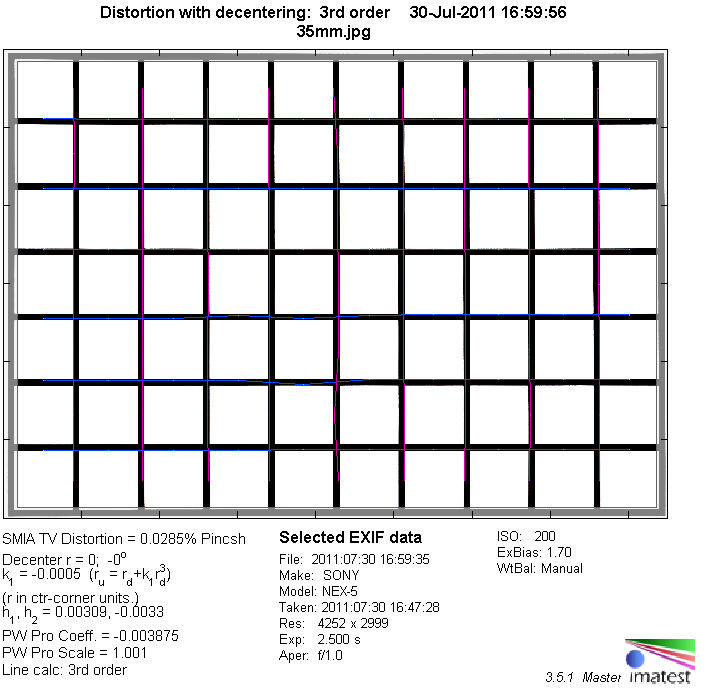|
Zeiss C Biogon T* 35mm f/2.8 ZM on Sony NEX - Review / Lab Test Report - Analysis |
|
Lens Reviews -
Sony Alpha/NEX (APS-C)
|
|
Page 2 of 2

Distortion
The Zeiss lens produces only a negligible amount of image distortion.

Vignetting
The Zeiss ZM lenses tend to have a rather mediocre vignetting characteristic on the Sony sensor - despite the original full format design - and the C Biogon has its share of issues here as well. At max. aperture it shows a fairly hefts amount of light falloff (1.3EV/f-stops). Stopping down improves the vignetting but it remains comparatively high even at f/8 (0.7EV).

MTF (resolution)
The Sony sensor seems to be a tricky being for "classic" lenses. The Biogon is renowned for delivering excellent results on film but the quality isn't quite as good on the NEX. The center resolution is exceptionally high across the relevant aperture range. However, the border quality isn't really impressive - it's only good (just) at f/2.8 and improves slowly when stopping down. The global peak performance is reached at f/8 with a very good performance across the image frame although the image center does already suffer from diffraction effects here.
Please note that the MTF results are not directly comparable across the different systems!
Below is a simplified summary of the formal findings. The chart shows line widths per picture height (LW/PH) which can be taken as a measure for sharpness.
If you want to know more about the MTF50 figures you may check out the corresponding Imatest Explanations
Chromatic Aberrations (CAs)
Lateral CAs (colors shadows towards the image borders) are generally well controlled. They have a moderate peak of 1.1px at max. aperture but decrease the more you stop down. The CAs are basically negligible beyond f/4 already.

Verdict
The Zeiss C Biogon T* 35mm f/2.8 is supposed to deliver great images on film but it doesn't really harmonize well with the Sony sensor of the NEX-5. The center image quality is simply great even at max. aperture but the border resolution is somewhat disappointing especially considering the moderate base aperture. The borders are still good (just) at f/2.8 and increase steadily till f/8 towards very good (just) results. The lateral CAs are low and distortions are basically absent. The vignetting characteristic is less than impressive at f/2.8 and still comparatively high beyond which is quite surprising for a full format lenses used on an APS-C camera. There's also a little reddish color shifts in the image corners which is something that we've already noticed on the ZM 28mm f/2.8.
The Biogon is a Leica M mount lens which can easily be used via a Leica M to E-mount adapter. Consequently you've to live without AF and an automatic aperture. However, thanks to the EVIL design of Sony NEX cameras (magnified focus view, LiveView) this is less of an issue compared to adapter solutions on DSLRs. The build quality of the Zeiss lens is superb thanks to an all-metal body and super-smooth controls. However, performance-wise it makes probably sense to go either for a Sony 35mm f/1.8 or 30mm f/2.8 (via Sony Alpha adapter) or just wait for the upcoming Sony E 30mm f/3.5 macro which should emerge later this year.
|